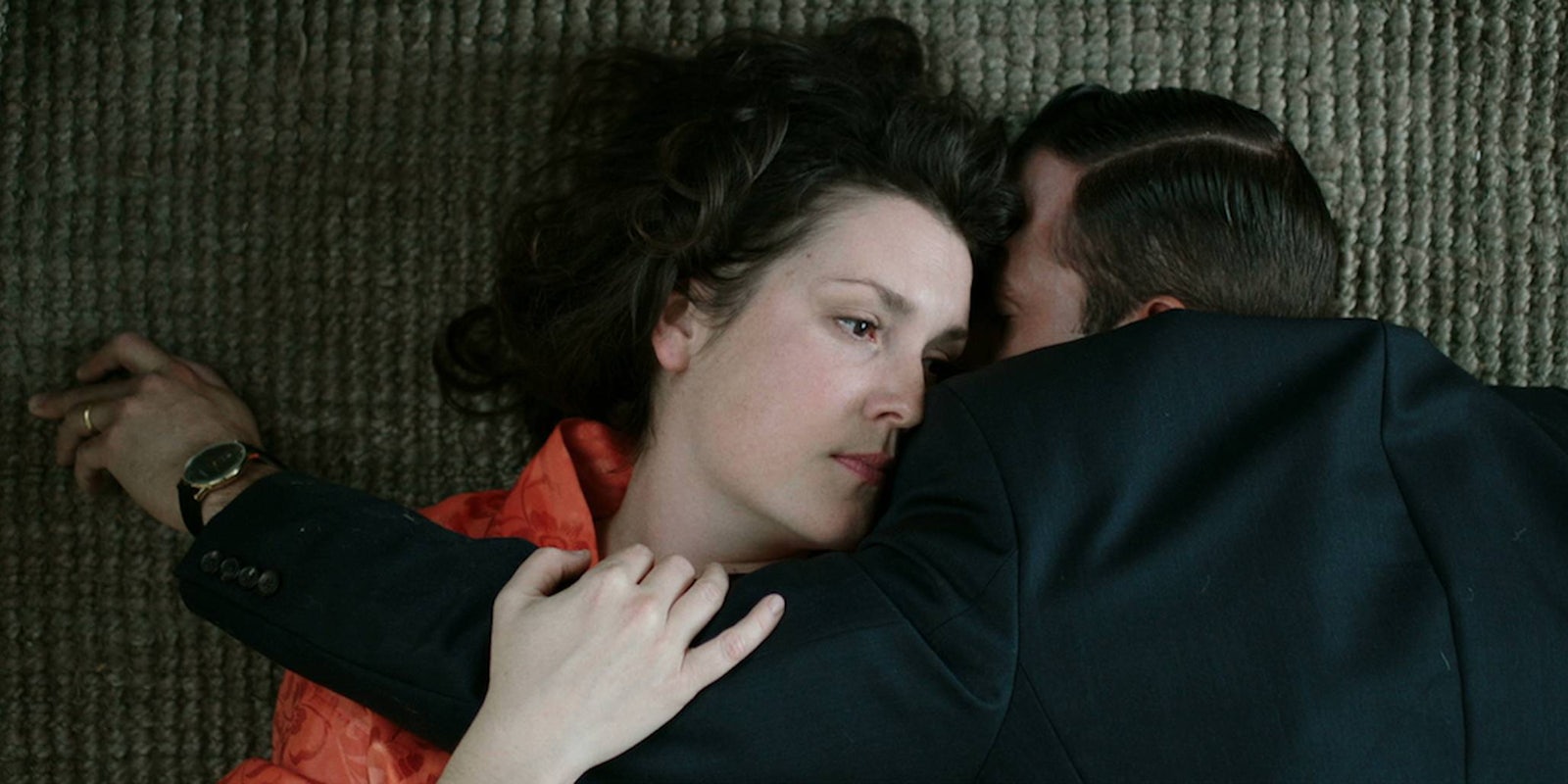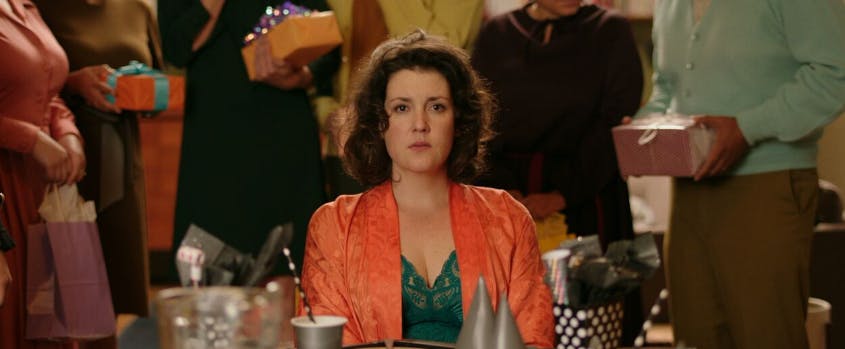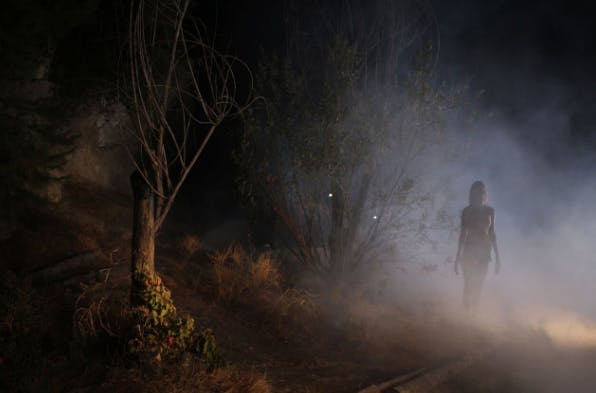In the new horror anthology XX, women are the focus. They’re monsters and mothers, the protectors and the possessed.
The idea for XX began with director Jovanka Vuckovic, who noticed that there weren’t any all-female productions within the new wave of horror anthologies like V/H/S and The ABCs of Death. She directs first segment “The Box,” in which a family is upended after its young son peeks inside a stranger’s box and stops eating. Scenes in which what he saw is “passed” on, quietly infecting the family, stand in contrast with overhead shots of luxurious plates of food and mother Susan (Natalie Brown) slowly realizing she’s powerless.
Karyn Kusama (The Invitation) directs “Her Only Living Son,” an update to Rosemary’s Baby. Here a single mother comes to grips with her teenage son’s growing power—and penchant for violence. There’s another possible homage: A scene where she scrubs up blood resembles one in Lynne Ramsay’s We Need to Talk About Kevin. Roxanne Benjamin (Southbound) helms campfire horror “Don’t Fall” and first-time director Annie Clark, better known as musician St. Vincent, steers “The Birthday Party.” The four segments are threaded together by Sofia Carrillo’s stop-motion art.
In the darkly comic “The Birthday Party,” co-written by Clark and Benjamin, Melanie Lynskey plays Mary, a mother who never even has time to remove her silk robe as she tries to plan her daughter’s birthday—and conceal her husband’s newly discovered body. She heaves him around her glass house, trying to hide him from her daughter and nosy neighbor Madeline (Lindsay Burdge), and devises an absurd disguise. There are hints of Hitchcock in dark-haired nanny Carla (Sheila Vand of A Girl Walks Home Alone at Night) and Mary’s impeccably dressed dead husband, but Lynskey is the segment’s sad-eyed, steely force, especially in the slow-motion finale when we finally get to the punchline.
Clark tells the Daily Dot it’s “kind of based on a true story” about having to make a decision about a dead body, as well as a “macro-comment” on the “unfortunate ways in which women get trained to be misogynistic towards other women.” But there’s also a thread about how many roles women have to play.
“She’s never unkind,” Clark says of Mary. “She’s just trying to protect her child.”
The film explores the parallels between comedy and horror, but Benjamin says they’re really the same thing. She points to a scene in “The Birthday Party” where Mary breaks down in the bathroom, after trying to keep her composure in front of her daughter.
“The context of the whole thing is just so brutal that you have to laugh,” Benjamin says. “Because if you don’t you’re just going to wither and die inside. So that’s comedy!”
“We saw it for the first time with an audience at Sundance,” Benjamin adds. “And they all laughed at that same point… It was such a ‘Oh my god, we’re not alone in the universe’ kind of moment.”
“And that’s the only reason to make art,” Clark says. “To feel not alone in the world. Because we’re all gonna die and we’re all alone.”
Whereas “The Birthday Party” is dark comedy, Benjamin’s “Don’t Fall” is a modern campfire tale packed with jump scares. Benjamin says Pet Sematary was a big reference point: “People go to the places they’re not supposed to that are protected in a certain way or damned in a certain way, and bad things happen… You get right into, here is the transgression and here is the repercussion.”
In the last few years, there have been several great films about women who are more than the “final girl,” who explore transgression and repercussion: Under the Skin, The Witch, It Follows, A Girl Walks Home Alone at Night, The Babadook. These films consider anxiety, mental illness, pleasure, hunger, power, loneliness, grief, sexuality, darkness—and women as the monsters.
But female horror directors are still a minority. The 2016 Celluloid Ceiling report found that women represented only 7 percent of directors in Hollywood—a decline from 2015—and were least likely to work in horror and action genres. And there still seem to be some antiquated ideas about women’s work there. Last year a male audience member told Julia Ducournau, director of upcoming cannibal thriller Raw, that he was glad women were creating horror films because it brings “softness”:
Softness? Have you seen my movie? When you make horror, it’s the expression of a form of violence that you feel inside of you—and it’s important we recognize that women feel violence and anger as well.
Asked which recent horror movie shook them, Benjamin and Clark both agree on Paul Verhoeven’s Elle, in which Isabelle Huppert plays a women who falls into a subversive relationship with the man who raped her.
“I would fucking Van Gogh my ear for Isabelle Huppert,” says Clark. “If she wanted my right ear, I would send it to her in a box.”
READ MORE:
- The 105 best movies on Netflix
- 6 heart-pounding kidnapping movies now streaming on Netflix
- The best Netflix original series
- What’s new on Netflix
Neither Clark nor Benjamin can typically stand sexual violence in films, but Elle proved the exception.
“It’s cheap but also in this film it was done in this way that’s so stylized and so emotionally and psychologically complicated,” Clark says. “I was so thrilled watching that movie and I was laughing so much. I was the only person laughing at the fucking theater, and it was in New York, too.”
After XX screened at Sundance last month, Kusama said, “Women have a lot to be really fucking afraid of.” Do movies like Elle signal a move toward films that explore the horror of just trying to exist in the world?
“I think every generation has its form of horror that reflects the society around it, and we’re very much at a time where everything is kind of upside down in terms of nobody knows what happens next,” says Benjamin. “And there’s a sense of not having your footing in reality, and I think that’s going to be a very big touchstone for the horror movies of the next couple of years.”
“I’m afraid of the color beige,” Clark adds.
“That’s not a joke,” Benjamin assures.




